

Tiberius Julius Abdes Pantera, Father of Jesus? The grave stone of a Roman soldier found in 1859 in Bingerbruck, Germany bears the name "Tiberius Julius Abdes Pantera of Sidon".

This is interesting because of a tradition, mainly sourced to the Talmud, holding that Pantera (or derivatives thereof) was the name of the father of Jesus. Further, an ancient rumor holds that Jesus was the bastard of an individual named Pantera (or derivations thereof). The Talmud does not say Pantera was a soldier; however, other ancient sources do repeat this charge. Sidon is an ancient Phoenician port city located in present day Lebanon, not far from Galilee.
Exorcism of the Gerasene demoniac. Medieval book illustration of Christ Exorcising the Gerasenes demonic The Exorcism of the Gerasene demoniac is one of the miracles of Jesus in the Gospels.[1] Narrative[edit] The Gospel of Mark reports the miracle as taking place when Jesus went across the lake to Gerasenes, the modern Jerash in Jordan.

There a man possessed by an evil spirit came from the caves to meet him. No one could bind this man anymore, not even with a chain, for no one was strong enough to subdue him. Pseudo-Methodius. Revelations of the Pseudo-Methodius.
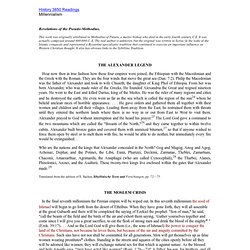
This work was originally attributed to Methodius of Patara, a martyr bishop who died in the early fourth century, C.E. It was actually composed around 660-680 C. E. The real author is unknown, but the original was written in Syriac in the wake of the Islamic conquests and represented a Byzantine apocalyptic tradition that continued to exercise an important influence on Western Christian thought.
It also has obvious links to the Sybilline Tradition. Jesus of Nazareth. In Morocco, on a pinchpenny budget of $6 million, Scorsese recreated a Palestine of sere deserts and balding meadows.

His style is impatient, intimate, conspiratorial, the camera scurrying ever closer to the heart of the matter — X-rays of souls in stress. In the Nikos Kazantzakis novel and Paul Schrader’s script, the director found a story like the one he has made again and again throughout his career, from Mean Streets to Raging Bull, from The King of Comedy to The Color of Money, from Goodfellas to Gangs of New York to The Departed: a toxic buddy movie, in which two men are bound by love or hate; one must betray the other and thereby help certify his mission.
The Scorsese Jesus (Willem Dafoe) is not God born as man; he is a man who discovers — or invents — his own divinity, and he’s both tormented and excited by the revelation. The Omen. Plot[edit] Soon after, Robert is appointed U.S.
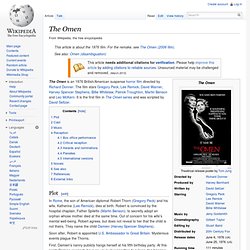
Ambassador to Great Britain. Mysterious events plague the Thorns. First, Damien's nanny publicly hangs herself at his fifth birthday party. At this point, Damien seems to have an unusual connection to a large dog hanging around the premises, as did the nanny prior to her hanging. Then, a new nanny or "governess", Ms. Having to attend a wedding ceremony, Katherine instructs Ms. Cartaphilus, The Wandering Jew, a Medieval Tale Based an Ancient Greek One.
Abstract The story of the eternal Jew really became popular in the seventeenth century when a pamphlet was printed in Leyden in 1602 alleging that the bishop of Schleswig had met the Wandering Jew at Hamburg in 1542.
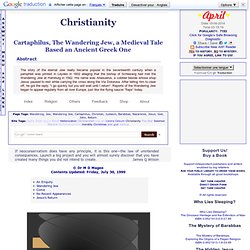
His name was Ahasuerus, a cobbler beside whose shop Jesus paused to rest while carrying the cross along the Via Dolorosa. After telling him to clear off, he got the reply, “I go quickly but you will wait until I return”. Reports of the Wandering Jew began to appear regularly from all over Europe, just like the flying saucer “flaps” today. If neoconservatism does have any principle, it is this one—the law of unintended consequences. Gabriel (film) Gabriel is a 2007 Australian action-horror film set in purgatory.
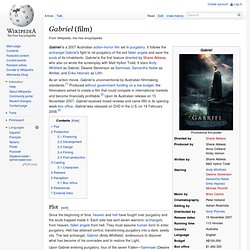
It follows the archangel Gabriel's fight to rid purgatory of the evil fallen angels and save the souls of its inhabitants. Gabriel is the first feature directed by Shane Abbess, who also co-wrote the screenplay with Matt Hylton Todd. It stars Andy Whitfield as Gabriel, Dwaine Stevenson as Sammael, Samantha Noble as Amitiel, and Erika Heynatz as Lilith. Since the beginning of time, heaven and hell have fought over purgatory and the souls trapped inside it.
Each side has sent seven warriors: archangels from heaven, fallen angels from hell. Muspilli. Parts of the Muspilli at the bottom of a page of the manuscript once in the possession of Louis the German Muspilli is one of two surviving pieces of Old High German epic poetry (the other being Hildebrandslied), dating to around 870.

One large fragment of the text has survived in the margins and empty pages of a codex marked as the possession of Louis the German and now in the Bayerische Staatsbibliothek (cim. 14098). The beginning and end of the poem have not survived. It was re-discovered in 1817 and first published in 1832 by Johann Andreas Schmeller, who also titled it Muspilli, after a central word in the text. The poem has been theorized as a Christianized version of the pagan Ragnarök, with figures represented in 13th century sources swapped with Christian figures; Surtr replaced by the Antichrist whom Elias – replacing Thor – fights, Loki by the old fiend.[1] In the Norse Ragnarök, Muspelheim and Muspell play a large role, and both versions involve a wolf.
Text[edit] Top 10 Medieval Urban Legends. History Who doesn’t love a good legend?
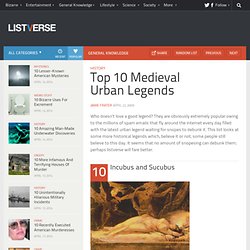
They are obviously extremely popular owing to the millions of spam emails that fly around the internet every day filled with the latest urban legend waiting for snopes to debunk it. This list looks at some more historical legends which, believe it or not, some people still believe to this day. It seems that no amount of snopesing can debunk them; perhaps listverse will fare better. An incubus is a demon in male form supposed to lie upon sleepers, especially women, in order to have sexual intercourse with them, according to a number of mythological and legendary traditions. Apocalypse of Thomas. The Apocalypse of Thomas is a work from the New Testament apocrypha, apparently composed originally in Greek.
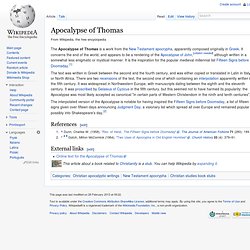
It concerns the end of the world, and appears to be a rendering of the Apocalypse of John,[citation needed] although written in a somewhat less enigmatic or mystical manner. It is the inspiration for the popular medieval millennial list Fifteen Signs before Doomsday.[1] The text was written in Greek between the second and the fourth century, and was either copied or translated in Latin in Italy or North Africa.
There are two recensions of the text, the second one of which containing an interpolation apparently written in the fifth century. It was widespread in Northwestern Europe, with manuscripts dating between the eighth and the eleventh century. References[edit] External links[edit] Apocalypse of Paul. The Apocalypse of Paul is a 3rd-century text of the New Testament apocrypha.[1] There is an Ethiopic version of the Apocalypse which features the Virgin Mary in the place of Paul the Apostle, as the receiver of the vision, known as the Apocalypse of the Virgin.
The text is not to be confused with the gnostic Apocalypse of Paul, which is unlikely to be related. Apocalypse of Stephen. The Apocalypse of Stephen is one of the New Testament apocrypha's texts. The Stephen in question is one of the Seven Deacons to the Apostles. The text describes a conflict at the very beginnings of Christianity about the nature of Jesus of Nazareth.
Stephen appears on the scene and recounts Revelation as a literal truth, to which the crowd declare blasphemy, and Caiaphas has him arrested and beaten. The text then has Stephen appear before Pilate whom he tells to not speak, and orders him to recognize Jesus. The tale is set before Paul of Tarsus' conversion, and so proceeds to describe how Paul persecutes Stephen by having him crucified. Gospel of Judas. The Gospel of Judas is a Gnostic gospel whose content consists of conversations between the apostle Judas Iscariot and Jesus. It is believed to have been written by Gnostic followers of Jesus, not by Judas himself, and, since it contains late 2nd century theology, probably dates from no earlier than the 2nd century. The only copy of the Gospel of Judas known to exist is a Coptic language text that has been carbon dated to AD 280, plus or minus 60 years. Adam Kadmon. Adam Kadmon is a phrase in the religious writings of Kabbalah meaning "original man".
The oldest mainstream rabbinic source for the term Adam ha-Ḳadmoni is Numbers Rabbah x., where Biblical Adam is styled, not as usually Ha-Rishon ("the first"), but "Ha-Kadmoni" ("the original"). Guf. In Jewish mysticism the Chamber of Guf (also Guph or even Gup) Hebrew for "body", also called the Otzar (Hebrew for "treasury"), is the Treasury of Souls, located in the Seventh Heaven. The Tree of Souls[edit] According to Rabbi Isaac Luria, the trees are resting places for souls and sparrows can see the soul's descent, explaining their joyous chirping. The Tree of Souls produces all the souls that have ever existed, or will ever exist. When the last soul descends, the world will come to an end.[2] According to the Talmud, Yevamot 62a, is that the Messiah will not come until the Guf is emptied of all its souls. In keeping with other Jewish legends that envision souls as bird-like, the Guf is sometimes described as a columbarium, or birdhouse.
History Channel GOD vs. Satan The Final Battle. Angels: Elect & Evil, Revised: C. Fred Dickason: 9780802407344. Dr. Dickason offers a detailed discussion on God's angelic creations and our relationship to them. Life of Adam and Eve. Songs of the Sabbath Sacrifice. War of the Sons of Light Against the Sons of Darkness. How, why, and when did Satan fall from heaven? Was Satan in charge of music in Heaven? Why did Satan think he could defeat God? Question: "Why did Satan think he could defeat God? " Answer: It’s hard to imagine a being who was as close to God as Lucifer (Satan) was coming to believe that he could even do battle with God, much less defeat Him. Even the most depraved mind should be able to see that the creature cannot possibly contend with the Creator. And yet Satan attempted to dethrone God and strives to this day to defy His authority, thwart His plans and harass His people. Perhaps part of the explanation is that pride, the worst and most evil of all sins, has blinded Satan to reality.
Two Old Testament passages (Isaiah 14:12-15 and Ezekiel 28:11-19) furnish a picture of Satan's original position and the reasons for his loss of that position. Satan's influence in worldly affairs is also clearly revealed (John 12:31). The reins of God on his activities are illustrated by Satan's request to God for permission to afflict Job (Job 1:7-12). Satan's nature is malicious. Who is The Devil, Satan? Names & descriptions of the devil: A. Satan isn't a "red, horned, long tailed being holding fork" 2 Cor 11:14. VITAL REMAINS lyrics. Samael. Samael (Hebrew: סמאל) (also Sammael or Samil) is an important archangel in Talmudic and post-Talmudic lore, a figure who is accuser, seducer and destroyer, and has been regarded as both good and evil.
Aggadah. Aggadah (Aramaic אַגָּדָה: tales, lore; pl. aggadot or (Ashkenazi) aggados; also known as aggad or aggadh) refers to the homiletic and non-legalistic exegetical texts in the classical rabbinic literature of Judaism, particularly as recorded in the Talmud and Midrash. In general, Aggadah is a compendium of rabbinic homilies that incorporates folklore, historical anecdotes, moral exhortations, and practical advice in various spheres, from business to medicine. Cacodemon. Wandering Jew. Study Tools. Jesus in the Talmud. Jewish Myth, Magic, and Mysticism: Moses the Magician.
Jewish Myth, Magic, and Mysticism: Solomon the Sorcerer. Some fundamental concerning Jesus' magic, “wonders”, wizardry and sorcery – demonstrated by an example. Acts of Pilate. The Names of Jesus. Jesus in the Talmud. Definitions of archaic words. The Gospel According to Mary Magdalene.